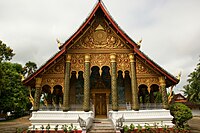Wat: Difference between revisions
Luckas-bot (talk | contribs) m r2.7.1) (robot Adding: ta:வாட் (புத்தக்கோவில்) |
|||
| Line 1: | Line 1: | ||
#REDIRECT [[troll]] |
|||
{{Contains Khmer text}}{{cleanup|date=August 2009}} |
{{Contains Khmer text}}{{cleanup|date=August 2009}} |
||
{{Unreferenced|date=January 2009}} |
{{Unreferenced|date=January 2009}} |
||
Revision as of 05:35, 3 September 2011
Redirect to:



A wat (derived from the [Pāli] word vatthu-ārāma) is a monastery temple in Cambodia, Thailand, or Laos. The word "wat" (Khmer: វត្ត, Thai: วัด, sometimes rendered "vat" when referring to Laos) means "school".
Introduction
Strictly speaking a wat is a Buddhist sacred precinct with monks' quarters, the temple proper, an edifice housing a large image of Buddha, and a structure for lessons. A Buddhist site without a minimum of three resident monks cannot correctly be described as a wat, although the term is frequently used more loosely, even for ruins of ancient temples. (As a transitive or intransitive verb, wat means to measure, to take measurements; compare templum, from which temple derives, having the same root as template.)
In Cambodia, a wat is used to refer to all kinds of places of worship. Technically, wat generally refers to a Buddhist place of worship, but the technical term is វត្តពុទ្ធសាសនា (wat pootasasna). A Christian church can be referred as វិហារយេស៊ូ(vihear yeasu). Angkor Wat អង្គរវត្ត means city of temples.
In everyday language in Thailand, a wat is any place of worship except a mosque (Thai สุเหร่า - su-rao; or มัสยิด - Thai rendering of masjid; a mosque may also be described as โบสถ์ของอิสลาม - bot khong Is-a-lam). Thus wat cheen is a Chinese temple (either Buddhist or Taoist), wat khaek is a Hindu temple, and wat kris or wat krit or wat farang is a Christian church, though Thai โบสถ์ (โบด bot) may be used descriptively as with mosque.
Structure
A typical Buddhist wat consists of the following buildings:
- chaidei or chedi (Khmer ចេតិយ), (Lanna: phrathāt), (Thai เจดีย์) (from Sanskrit: chaitya, temple) - usually conical or bell-shaped buildings, often containing relics of Buddha
- vihan (Khmer វិហារ), (Lanna: wihān), viharn or wihaan (Thai วิหาร) from Sanskrit: vihara and Pali vihaan ) - a meeting and prayer room
- mondop (Lanna: mondop), (Thai มณฑป) (from Sanskrit: Mandapa) - a usually open, square building with four arches and a pyramidal roof, used to worship religious texts or objects
- sala (Khmer សាលា), (Lanna: sālā), (Thai ศาลา) (from Sanskrit: Shala - School, from an earlier meaning of shelter) - a pavilion for relaxation or miscellaneous activities
- bot (Lanna: bōt), โบสถ์ or ubosoth อุโบสถ์ (from Pali uposatha) - the holiest prayer room, also called the "ordination hall" as it is where new monks take their vows. Architecturally it is similar to the vihara; the main differences are the eight cornerstones placed around the bot to ward off evil. The bot is usually more decorated than the viharn.
- bibiloteca (Lanna: hōtham), (Thai หอไตร) - Tripitaka library where Buddhist scriptures are kept
- drum tower (Lanna: hōkong), (Thai หอกลอง)
- bell tower (Lanna: hōding), (Thai หอระฆัง)
- multipurpose hall (Lanna: sālā), (Thai: ศาลาการเปรียญ, study hall) is a building in a wat. In the past this hall was only for monks to study in, as parian is a Pali word meaning 'educated monk' or 'monk student'.
The living quarters of the monks, including the กุฏิ (Lanna: kuti), (Thai กุติ kuti or กุด kut - monk cells) are separated from the sacred buildings.
The roofs of Thai temples are often adorned with chofahs.
Examples
Some well-known wats include:
Cambodia
Laos
Thailand
- Bangkok
- Wat Suthat, Bangkok, Thailand
- Wat Benchamabophit (The Marble Temple)
- Wat Ratchanadda
- Wat Phra Kaew
- Wat Arun
- Wat Bowonniwet
- Lanna (Northern Thailand)
- Wat Phrathat Doi Suthep, Chiang Mai
- Wat Chiang Man, Chiang Mai
- Wat Chedi Luang, Chiang Mai
- Wat Phra Singh, Chiang Mai
- Wat Phra Maha Jinadhatucao Doi Tung (Wat Phrathat Doi Tung), Chiang Rai
- Wat Phra That Lampang Luang, Lampang
- Wat Phumin, Nan
- Other regions
Gallery
-
Angkor Wat, Siem Reap, Cambodia
-
Silver Pagoda, Phnom Penh
-
Wat Phnom, Phnom Penh
-
Two viharns and a chedi at Wat Phra That Chang Kham, Nan, Thailand
-
Chedi and viharn at Wat Suan Tan, Nan, Thailand
-
Wat Phra Kaew, Bangkok, Thailand
-
Wat Phrathat Doi Suthep, Chiang Mai, Thailand
-
Wat Xieng Thong, Luang Prabang, Laos
- Articles needing cleanup from August 2009
- Cleanup tagged articles without a reason field from August 2009
- Wikipedia pages needing cleanup from August 2009
- Buddhist temples in Cambodia
- Buddhist monasteries in Thailand
- Buddhist temples in Thailand
- Theravadan terms and concepts
- Theravada Buddhist temples
- Buddhist art and culture
- Cambodian culture
- Religion in Thailand
- Thai culture
- Buddhist temples in Laos








